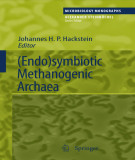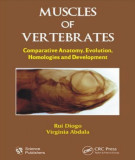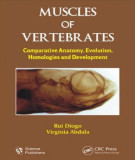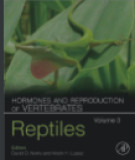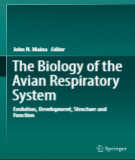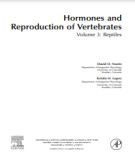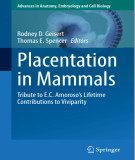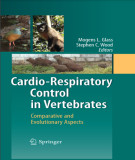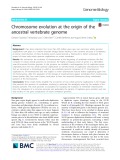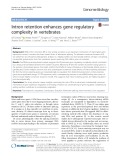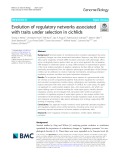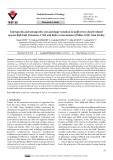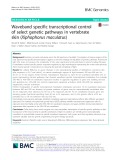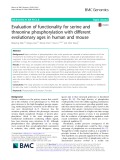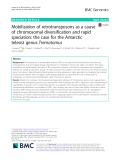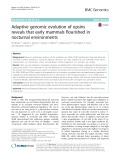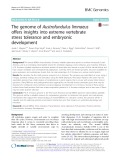
Vertebrate evolution
-
Ebook "(Endo)symbiotic methanogenic archaea" updated monograph deals with methanogenic endosymbionts of anaerobic protists, in particular ciliates and termite flagellates, and with methanogens in the gastrointestinal tracts of vertebrates and arthropods. Further chapters discuss the genomic consequences of living together in symbiotic associations, the role of methanogens in syntrophic degradation, and the function and evolution of hydrogenosomes, hydrogen-producing organelles of certain anaerobic protists.
 245p
245p  tachieuhoa
tachieuhoa
 28-01-2024
28-01-2024
 4
4
 2
2
 Download
Download
-
Part 1 book "Muscles of vertebrates - Comparative anatomy, evolution, homologies and development" includes content: Introduction and aims, methodology and material, muscles of non osteichthyan vertebrates, head and neck muscles of actinopterygians and basal sarcopterygians; from sarcopterygian fish to modern humans - head muscles and neck.
 214p
214p  muasambanhan03
muasambanhan03
 25-12-2023
25-12-2023
 6
6
 1
1
 Download
Download
-
Part 2 book "Muscles of vertebrates - Comparative anatomy, evolution, homologies and development" includes content: Head and neck muscles of amphibians; head and neck muscles of reptiles; pectoral and pectoral fin muscles of actinopterygian and sarcopterygian fishes; from sarcopterygian fish to modern humans - pectoral and forelimb muscles; pectoral and forelimb muscles of limbed amphibians and reptiles; general comments.
 267p
267p  muasambanhan03
muasambanhan03
 25-12-2023
25-12-2023
 2
2
 1
1
 Download
Download
-
Part 2 book "Hormones and reproduction of vertebrates (Vol 3: Reptiles)" includes content: Hormones and behavior of reptiles, viviparity in reptiles - evolution and reproductive endocrinology; hormones and reproductive cycles in turtles; hormones and reproductive cycles in crocodilians; hormones and reproductive cycles in lizards; hormones and reproductive cycles in snakes; endocrine disruption of reproduction in reptiles.
 196p
196p  muasambanhan01
muasambanhan01
 13-12-2023
13-12-2023
 8
8
 4
4
 Download
Download
-
Part 1 book "The biology of the avian respiratory system - Evolution, development, structure and function" includes content: The evolution of birds with implications from new fossil evidences, the avian lingual and laryngeal apparatus within thecontext of the head and jaw apparatus, withcomparisons to the mammalian; pulmonary transformations of vertebrates; flying high - the unique physiology of birds that fly at high altitudes.
 141p
141p  oursky09
oursky09
 08-11-2023
08-11-2023
 9
9
 2
2
 Download
Download
-
Part 2 book "Hormones and reproduction of certebrates (Vol 3 - Reptiles)" includes content: Hormones and behavior of reptiles viviparity in reptiles; evolution and reproductive endocrinology; hormones and reproductive cycles in turtles, hormones and reproductive cycles in crocodilians; hormones and reproductive cycles in lizards; hormones and reproductive cycles in snakes; endocrine disruption of reproduction in reptiles.
 196p
196p  oursky05
oursky05
 20-09-2023
20-09-2023
 7
7
 3
3
 Download
Download
-
Part 1 book "Placentation in mammals" includes content: Mammalian placentation - a tribute to E.C. amoroso´s contributions to placenta development, the evolution of viviparity in vertebrates, development of pre implantation mammalian blastocyst, placentation in marsupials, the early stages of implantation and placentation in the pig, placentation in equids.
 137p
137p  oursky05
oursky05
 20-09-2023
20-09-2023
 4
4
 2
2
 Download
Download
-
Part 2 book "Cardio-respiratory control in vertebrates - Comparative and evolutionary aspects" includes content: Evolution of pulmonary mechanics and respiratory control, respiratory physiology of birds - metabolic control, mammalian and human physiology.
 297p
297p  oursky04
oursky04
 14-09-2023
14-09-2023
 4
4
 3
3
 Download
Download
-
It has been proposed that more than 450 million years ago, two successive whole genome duplications took place in a marine chordate lineage before leading to the common ancestor of vertebrates. A precise reconstruction of these founding events would provide a framework to better understand the impact of these early whole genome duplications on extant vertebrates.
 15p
15p  vigalileogalilei
vigalileogalilei
 27-02-2022
27-02-2022
 13
13
 1
1
 Download
Download
-
Genome duplication has played a pivotal role in the evolution of many eukaryotic lineages, including the vertebrates. A relatively recent vertebrate genome duplication is that in Xenopus laevis, which resulted from the hybridization of two closely related species about 17 million years ago.
 18p
18p  vialfrednobel
vialfrednobel
 29-01-2022
29-01-2022
 12
12
 0
0
 Download
Download
-
While intron retention (IR) is now widely accepted as an important mechanism of mammalian gene expression control, it remains the least studied form of alternative splicing. To delineate conserved features of IR, we performed an exhaustive phylogenetic analysis in a highly purified and functionally defined cell type comprising neutrophilic granulocytes from five vertebrate species spanning 430 million years of evolution.
 15p
15p  vialfrednobel
vialfrednobel
 29-01-2022
29-01-2022
 2
2
 0
0
 Download
Download
-
Seminal studies of vertebrate protein evolution speculated that gene regulatory changes can drive anatomical innovations. However, very little is known about gene regulatory network (GRN) evolution associated with phenotypic effect across ecologically diverse species.
 28p
28p  viarchimedes
viarchimedes
 26-01-2022
26-01-2022
 9
9
 0
0
 Download
Download
-
Anurans are the most suitable vertebrate group to see the development and also evolution in the skull, compared to other terrestrial vertebrates as they show highly derived morphology. For this reason, the cranium of anurans has been widely used for analyzing e.g., development and integration, evolutionary history, phylogenetic relationships, sexual dimorphism; and for taxon determination. We applied geometric morphometric techniques and then multivariate statistical analyses to see the skull size and shape variations in closely related Bufo species (B. bufo and B.
 11p
11p  dolomite36
dolomite36
 30-12-2021
30-12-2021
 14
14
 0
0
 Download
Download
-
Evolution occurred exclusively under the full spectrum of sunlight. Conscription of narrow regions of the solar spectrum by specific photoreceptors suggests a common strategy for regulation of genetic pathways. Fluorescent light (FL) does not possess the complexity of the solar spectrum and has only been in service for about 60 years. If vertebrates evolved specific genetic responses regulated by light wavelengths representing the entire solar spectrum, there may be genetic consequences to reducing the spectral complexity of light.
 18p
18p  vibeauty
vibeauty
 23-10-2021
23-10-2021
 7
7
 0
0
 Download
Download
-
Rapid evolution of phosphorylation sites could provide raw materials of natural selection to fit the environment by rewiring the regulation of signal pathways. However, a large part of phosphorylation sites was suggested to be non-functional. Although the new-arising phosphorylation sites with little functional implications prevailed in fungi, the evolutionary performance of vertebrate phosphorylation sites remained elusive.
 9p
9p  vibeauty
vibeauty
 23-10-2021
23-10-2021
 7
7
 1
1
 Download
Download
-
The importance of transposable elements (TEs) in the genomic remodeling and chromosomal rearrangements that accompany lineage diversification in vertebrates remains the subject of debate. The major impediment to understanding the roles of TEs in genome evolution is the lack of comparative and integrative analyses on complete taxonomic groups.
 18p
18p  vibeauty
vibeauty
 23-10-2021
23-10-2021
 3
3
 0
0
 Download
Download
-
Adaptive genomic evolution of opsins reveals that early mammals flourished in nocturnal environments
Based on evolutionary patterns of the vertebrate eye, Walls (1942) hypothesized that early placental mammals evolved primarily in nocturnal habitats. However, not only Eutheria, but all mammals show photic characteristics (i.e. dichromatic vision, rod-dominated retina) suggestive of a scotopic eye design.
 12p
12p  vibeauty
vibeauty
 23-10-2021
23-10-2021
 8
8
 1
1
 Download
Download
-
Our results reveal that distinct functional promoter classes and overlapping promoter codes are present in protochordates like in vertebrates, but show extraordinary lineage-specific innovations. Furthermore, we uncover a genome-wide, developmental stage-specific shift in the mode of TSS selection. Our results provide a rich resource for the study of promoter structure and evolution in Metazoa.
 12p
12p  vibeauty
vibeauty
 23-10-2021
23-10-2021
 13
13
 0
0
 Download
Download
-
The annual killifish Austrofundulus limnaeus inhabits ephemeral ponds in northern Venezuela, South America, and is an emerging extremophile model for vertebrate diapause, stress tolerance, and evolution. Embryos of A. limnaeus regularly experience extended periods of desiccation and anoxia as a part of their natural history and have unique metabolic and developmental adaptations. Currently, there are limited genomic resources available for gene expression and evolutionary studies that can take advantage of A. limnaeus as a unique model system.
 21p
21p  vibeauty
vibeauty
 23-10-2021
23-10-2021
 5
5
 0
0
 Download
Download
-
Functional communications between nervous, endocrine and immune systems are well established in both vertebrates and invertebrates. Circulating hemocytes act as fundamental players in this crosstalk, whose functions are conserved during the evolution of the main groups of metazoans. However, the roles of the neuroendocrineimmune (NEI) system in shrimp hemocytes during pathogen infection remain largely unknown.
 14p
14p  visilicon2711
visilicon2711
 20-08-2021
20-08-2021
 13
13
 1
1
 Download
Download
CHỦ ĐỀ BẠN MUỐN TÌM








